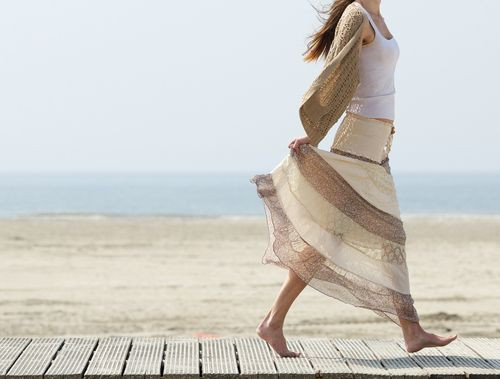Stand Up For Your Health: Sitting Less And Moving More Protects DNA From Aging

It’s no surprise most of us willingly spend hundreds and hundreds of dollars on bizarre beauty treatments, cosmetic procedures, and facials creams to reverse the effects of aging. While we succumb to the false promises of beauty products that claim to be anti-aging, and reduce fine lines and wrinkles, the key to looking and being forever young may actually lie in the soles of our feet. According to a recent study published in the British Journal of Sports Medicine, sitting down less and standing up more can actually protect our DNA from aging by lengthening telomeres, which would increase our lifespan.
When it comes to living longer, science suggests telomere size does matter. Telomeres, which sit on the end of chromosomes in cells, stop chromosomes from fraying, clumping together, and altering genetic code, says the University of Utah Health Sciences Center. Without telomeres, our genetic information would degrade and lead to cellular malfunction, which can increase our susceptibility to disease, and even death. These tiny segments of DNA may possibly contain insights into staying healthy and living longer.
Dr. Mai-Lis Hellenius, lead author of the study and a professor of cardiovascular disease prevention in the Department of Medicine, Karolinska Institutet, Karolinska University Hospital, Stockholm, Sweden, told Medscape Medical News, “Long telomeres are linked to a longer, healthier life.” Telomere length is influenced by cell division as we age. DNA damage over the years can wear telomeres down by aging and eventually breaking down. However, the production of Telomerase — the enzyme that lengthens telomeres and prevents them from eroding — may help prevent cells from dying, which may help preserve telomere length.
Although previous research suggests people who exercise more tend to have longer telomeres, Hellenius and colleagues hypothesize sitting less is of greater important than an increase in exercise. A total of 49 68-year-old, sedentary, overweight individuals were recruited for the study to measure telomere length in blood cells six months apart. The participants were divided into two groups: an exercise program that lasted six months, and the others were not part of any exercise regime.
The researchers measured physical activity with a seven-day diary, questionnaires, and a pedometer. Sitting time was measured with the short version of the International Physical Activity Questionnaire. The relationship between these measures would help determine their effect on telomere length.
The findings revealed the less time a person spent sitting, the longer their telomeres, and the higher the chance of living longer. The time spent exercising, as well as the number of steps taken daily, increased significantly in the group assigned the exercise program. However, the amount of time spent seated fell in both groups, as risk factors for heart disease and stroke also improved in both groups. Those in the exercise program did lose more weight.
"Our DNA will be damaged during a lifetime," Hellenius said. "It's damaged by bad diets, smoking, infections, and so on. Our capability to copy and produce new DNA and new cells is so important." Spending more time on your own two feet may protect your DNA, and be the secret to lengthening not only your telomeres, but your longevity.
The study is a small one and warrants further research before applying this to a larger population. However, supporting research shows people who spend more time sitting have shorter lives, regardless if they exercise on a regular basis. Reducing sitting time and other sedentary-related behavior can, apparently, help keep you forever young.
"So I think you can say to our patients yes, it's important to break up sedentary time and take a break for one or two minutes every 30 minutes," Hellenius said.
It’s time to get up and stand up for your health.
Source: Fisher R, Helenius ML, Kallings L et al. Stand up for health—avoiding sedentary behaviour might lengthen your telomeres: secondary outcomes from a physical activity RCT in older people. British Journal of Sports Medicine. 2014.



























